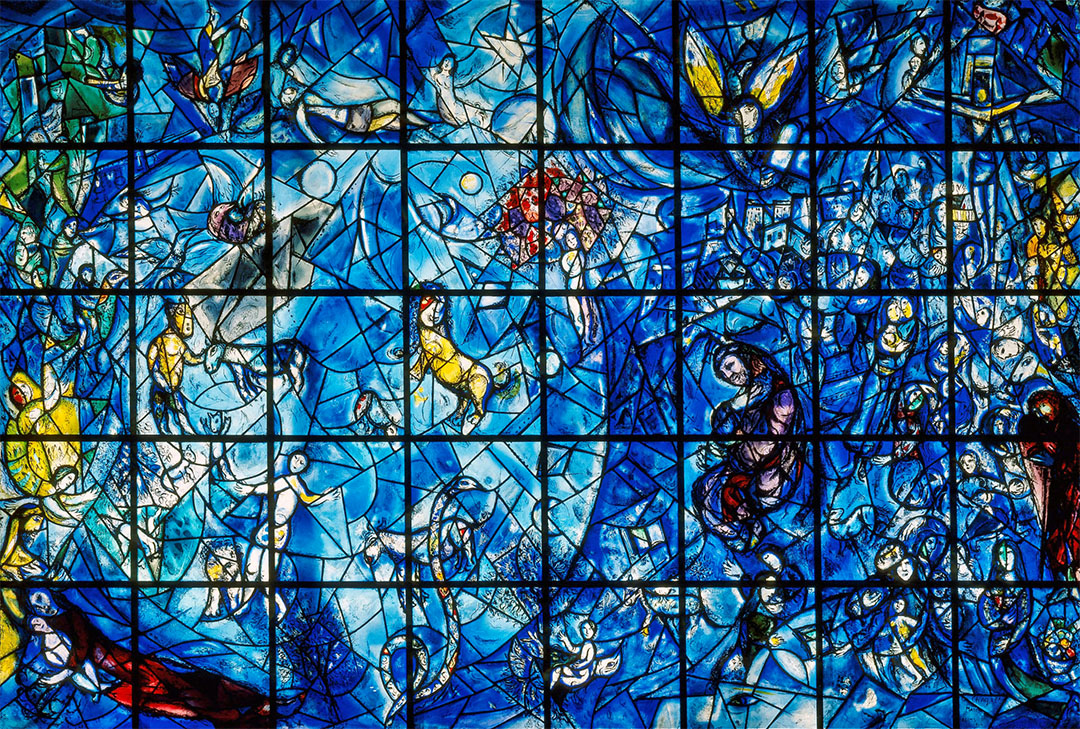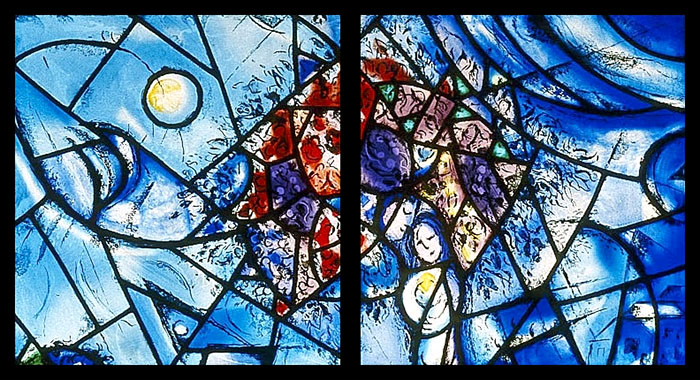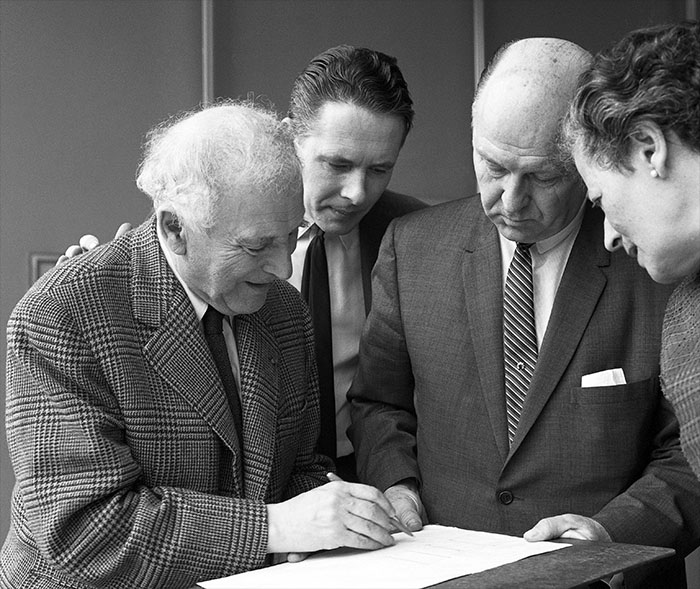A Thing of Beauty _|_ Issue 1, 2016
A Thing of Beauty…
Jane Clark contemplates the Chagall Peace Window and the Meditation Room in the United Nations building, New York


A Thing of Beauty…
Jane Clark contemplates the Chagall Peace Window and the Meditation Room in the United Nations building, New York
This beautiful, vibrant stained glass window was given to the United Nations in 1964 as a memorial to its second Secretary-General, Dag Hammerskjöld, and the fifteen other people who were tragically killed in a plane crash three years earlier. It is one of many great creations in stained glass produced by Chagall late in his life; he was 70 when he made his first venture into the medium, but between 1956 and 1984, the year before his death at the age of 97, he made transcendentally beautiful windows in a wide range of locations and venues; in cathedrals in Metz, Reims. Chichester and Mainz; in the Hasdassah Medical Centre in Jerusalem; in the auditorium in the National Museum in Nice; in country churches in Switzerland and in Kent.
This window, whose full title is “The Window of Peace and Human Happiness”, is one of his largest and most ambitious projects. Standing about 15 feet (4.6 m) wide and 12 feet (3.7 m) tall, it is a visual tribute to the principles upon which the United Nations is founded. As is the case in nearly all Chagall’s later works, it was inspired by a Biblical passage, Isaiah 9, 1–7:
The people that walked in darkness
Have seen a great light;
On those who live in a land of deep shadow
A light has shone.
You have made their gladness greater
You have made their joy increase.
They rejoice in your presence
As men rejoice at harvest time…
For every footgear of battle
Every cloak rolled in blood
Is burnt
And consumed by fire.
For there is a child born for us,
A son given to us
And dominion is on his shoulders
And this is the name they give him:
Wonder-counsellor, Mighty-God,
Eternal-Father, Prince of Peace.
Wide is his dominion
in a peace that has no end.
The window is full of motifs from the Old and the New Testaments. Rising up from the ground is a great tree which divides the panel into two halves. This is clearly the tree of knowledge, as we see next to it the infamous snake which seduced Adam and Eve into eating the apple. On the left is paradise, full of light, where human beings, animals and angels co-exist in joy and peace.
In the upper middle an angel kisses a girl amidst a bunch of glorious red and purple flowers which, for Chagall, always symbolize love. This is the central image of the window which immediately catches the eye. It calls to mind the ‘kiss of peace’ of the New Testament, which signifies love and harmony between heaven and earth.

Or is there a more mystical meaning, indicating union with God and the infusion of the Holy Spirit into creation? If so, the fact that the recipient is a beautiful young girl would associate it with the Annunciation. Or, given that the window is also said to have had Beethoven’s Ninth Symphony – Hammarskjöld’s favourite piece of music – as a source of inspiration, is there a reference here to Schiller’s great Ode to Joy which includes the lines: “Be embraced, you millions!/ This kiss is for the whole world!”?
On the right hand, darker side of the window is the fallen world, where people have to struggle for peace. At the top edge, a descending angel brings down the Ten Commandments to a walled city, whilst on the far right is the crucifixion, with a great crowd surging towards it. In the lower centre, a couple tenderly hold their new-born child, and a woman – the largest figure in the whole picture but darkened by her engulfing cloak – kneels in grief. There is nothing to indicate this but it is somehow clear that this is a mother who represents all mothers, grieving for her children sacrificed in war. The whole window is suffused with shades of the glorious blue – “mystical blue” – which is the hallmark of Chagall’s glass.

Marc Chagall sketches out the initial design of the window with members of the UN Memorial Committee. UN Photo
Chagall was almost unique amongst the great 20th-century artists in never abandoning the religious symbolism with which he was brought up. His contemporaries – such as Matisse and Picasso in Europe, or Rothko and Newman in USA – sought to develop new visual vocabularies which they thought more suitable for the modern era. But for Chagall, brought up as a Hassidic Jew in a small Russian town (now in modern-day Belarus) full of synagogues and churches, the physical and imaginal landscape of his childhood continued to inform his work to the very end.
In 1973, at the inauguration of the permanent exhibition of his large Biblical canvases in Nice, he said:
If every life inevitably moves towards its end, we must, during our own, colour it with the colours of hope and love. The social logic of life and the essence of every religion is in this love. For me, perfection in art and in life spring from the Biblical spring. Without that spirit, the mechanics of logic and construction alone…will not bear fruit.
This passionate attachment to the spiritual truths he discovered in the sacred text found particular expression in the medium of glass. In his collected essays, he says:
For me a stained glass window is a transparent partition between my heart and the heart of the world. Stained glass has to be serious and passionate. It is something elevating and exhilarating. It has to live through the perception of light. To read the Bible is to perceive a certain light, and the window has to make this obvious through its simplicity and grace…
The Peace Window is deeply informed by the largeness of Chagall’s vision: by his compassion and tolerance and, as a Jewish artist who lived in exile from a beloved homeland for most of his adult life and witnessed both world wars, by his deep understanding of human suffering. He elevates the symbolic language of one specific spiritual tradition to the level of universal meaning, making it something to which all people can relate.
The meditation room which is located next to it, by contrast, takes a completely different approach and seeks to find a universal symbolism which has no attachment to any particular religious belief. This was designed by Dag Hammarskjöld himself a few years before he died, and together with the Peace Window and a small exhibition outlining his life and work, it is de facto a memorial to this remarkable man.
Born in Sweden in 1905, Hammarskjöld was a brilliant economist and diplomat who was appointed Secretary General of the UN at the age of 47 – the youngest ever – and was subsequently awarded the Nobel Peace Prize posthumously. John F. Kennedy described him as the greatest statesman of the 20th century. But he was also a deeply spiritual person, whose diary, in which he noted his private thoughts and reflections without any reference to external events, was published after his death as Markings. It reveals him as a self-aware and dedicated student of the great medieval mystics such as Meister Eckhart and Jan van Ruysbroeck, whose inner effort was directed towards self-surrender and service. His friend W.H. Auden describes him in the preface as a unique example of man who tried “to unite in one life the via activa and the via contemplativia”, sustained by the belief that: “In our era, the road to holiness necessarily passes through the world of action.”
This is what Hammarskjöld says about the concept behind the meditation room, as written on a notice outside the door:
We all have within us a centre of stillness surrounded by silence. This house, dedicated to work and debate in the service of peace, should have one room dedicated to silence in the outward sense and stillness in the inner sense. It has been the aim to create in this small room a place where the doors may be open to the infinite lands of thought and prayer.
People of many faiths will meet here, and for that reason none of the symbols to which we are accustomed in our meditation could be used. However, there are simple things which speak to us all in the same language. We have sought for such things and believe that we have found them in the shaft of light striking the shimmering surface of solid rock.
So, in the middle of the room, we see a symbol of how, daily, the light of the skies gives life to the earth on which we stand, a symbol to many of us of how the light of spirit gives its light to matter.
But the stone in the middle of the room has more to tell us. We may see it as an altar, empty not because there is no God, not because it is an altar to an unknown god, but because it is dedicated to the God whom man worships under many names and forms.
The stone in the middle of the room reminds us also of the firm and permanent in a world of movement and change. The block of iron ore has the weight and solidity of the everlasting. It is reminder of that cornerstone of endurance and faith on which all human endeavour must be based.
The material of the stone leads our thoughts to the necessity for choice between destruction and construction, between war and peace. Of iron man has forged his swords, of iron he has made his ploughshares. Of iron he has constructed tanks, but of iron he has likewise built homes… The block of iron is part of the wealth we have inherited on this earth of ours. How are we to use it?
The shaft of light strikes the stone in a room of utter simplicity. There are no other symbols, there is nothing to distract our attention or to break in on the stillness within ourselves. When our eyes travel from these symbols to the front wall they meet a simple pattern opening up the room to the harmony, freedom and simplicity of space.
There is an ancient saying that the sense of a vessel is not in its shell but in the void. So it is with this room. It is for those who come here to fill the void with what they find in their centre of stillness.

View of the Meditation Room. The fresco on the back wall is the work of Swedish artist Bo Beskow. UN Photo
The room itself lives up to its brief. It is simple in the extreme, in stark contrast to the life and colour of the Chagall Peace window. But it has its own beauty as a quiet and tranquil space. Situated just opposite the security desks in the lobby of the main United Nations building, through which everyone who enters must pass – visitors, staff, delegates hurrying to attend one of the numerous assemblies and meetings which take place here every day, government ministers arriving for peace negotiations – it invites us to sit for a moment and reflect on essential matters.
I have chosen to write about these two beautiful installations by two great 20th-century visionaries in this first ‘issue’ of the relaunched Beshara Magazine because I feel that they constitute a very direct symbol of the intentions behind the Magazine, as expressed in its sub-title “A Unifying Perspective in the Contemporary World”. In both the meanings they embody and their position within a building devoted to global harmony, they are reminders to us that the aspiration for human unity and peace is not just a matter of political compromise and negotiation, of fragile cease-fires. Unity is not achievable when it is conceived as merely bringing together a collection of parts. It requires something greater, a more comprehensive vision which neither Chagall nor Hammarskjöld hesitated to relate to the sphere of the spirit, and spiritual truth.
This vision, as Chagall so magnificently expresses, is one of hope, happiness and joy. And it necessarily includes considerations of beauty. Therefore, this article is the first in a series under the heading of “A Thing of Beauty…” which will be a regular feature in the Magazine. For, as the environmentalist Sandra Labarsky has said:
Beauty is not a quality – blue or shiny or well-proportioned or a composite of these – overlaid on substance. It is embedded in life, part of the dynamic, relational structure of the world created by a concert of living beings. And it is what we name those relational structures that encourage freshness and zest so that life can continue to make life…
Sources (click to open)
Main Image: Stained Glass Composition. UN Photo by Lois Conner.
Catalogue of the National Museum of Nice. The quote is from the introduction by Jean-Michel Foray, pp.9–10.
BENJAMIN HARSHAV (Ed): Marc Chagall on Art and Culture, Stanford University Press 2003. The quote (pp.145–6) is from his inaugural address for the stained glass in the Hadassah Medical Centre, Jerusalem in 1960.
DAG HAMMARSKJÖLD: Markings, first edition 1964, Vintage Spiritual Classics 2006.
SANDRA LUBARSKY: “Living Beauty” in Keeping the Wild: Against the Domestication of the Earth, Island Press 2014. Quote pp. 194–5.
Email this page to a friend
FOLLOW AND LIKE US
——————————————
——————————————
——————————————
FOLLOW AND LIKE US
If you enjoyed reading this article
Please leave a comment below.
Please also consider making a donation to support the work of Beshara Magazine. The magazine relies entirely on voluntary support. Donations received through this website go towards editorial expenses, eg. image rights, travel expenses, and website maintenance and development costs.
